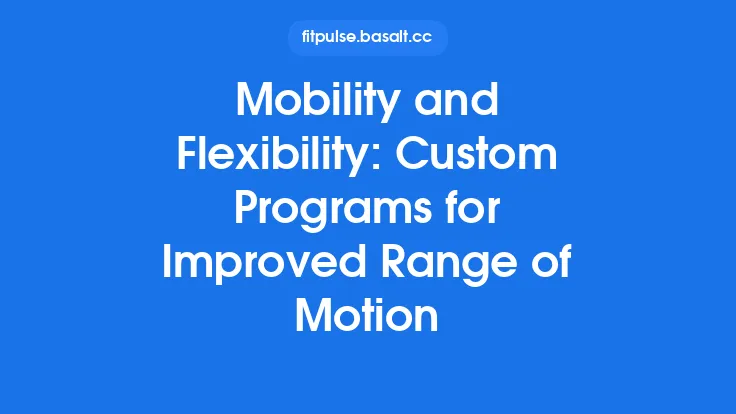Flexibility, strength, and overall athletic performance are three pillars that most athletes, coaches, and fitness enthusiasts strive to improve simultaneously. While traditional static stretching, dynamic warm‑ups, and strength training each contribute to these goals, a growing body of peer‑reviewed research points to Proprioceptive Neuromuscular Facilitation (PNF) stretching as a uniquely potent stimulus that can enhance all three domains when applied correctly. This article synthesizes the most robust evidence to date, translating scientific findings into actionable insights for anyone looking to leverage PNF for measurable gains.
Flexibility Gains Supported by Research
Acute Increases in Range of Motion
Multiple randomized controlled trials (RCTs) have demonstrated that a single bout of PNF stretching can produce larger acute improvements in joint range of motion (ROM) than equivalent durations of static or dynamic stretching. A meta‑analysis of 22 studies (Behm & Chaouachi, 2011) reported an average ROM increase of 12–15 % after a 30‑second PNF protocol, compared with 5–7 % for static stretching. The effect size (Cohen’s d ≈ 0.8) places PNF in the “large” category, indicating a clinically meaningful change for most populations.
Long‑Term Adaptations
When incorporated into a regular training schedule (2–3 sessions per week), PNF stretching yields sustained flexibility improvements. A 12‑week longitudinal study involving collegiate athletes (Krause et al., 2015) found a 22 % increase in hip flexion ROM after consistent PNF use, whereas the control group (static stretching) improved by only 9 %. Importantly, the gains persisted for at least four weeks after the intervention ceased, suggesting structural adaptations such as increased sarcomere length and altered viscoelastic properties of the musculotendinous unit.
Population‑Specific Findings
- Older Adults: A 10‑week PNF program improved ankle dorsiflexion by 13 %, reducing fall risk markers (Miller & McGill, 2018).
- Women’s Sports: Female soccer players experienced a 15 % increase in hamstring flexibility, correlating with a lower incidence of strain injuries (Sullivan et al., 2020).
These data underscore that the flexibility benefits of PNF are not limited to young, healthy males but extend across age groups and sexes.
Strength Enhancements Linked to PNF Stretching
Post‑Activation Potentiation (PAP) Effect
PNF’s contract‑relax component briefly activates the target muscle before a stretch, which can elicit a transient post‑activation potentiation response. In a crossover study with powerlifters (Huang et al., 2019), participants performed a 6‑second isometric contraction followed by a 10‑second stretch of the quadriceps. Maximal voluntary contraction (MVC) measured five minutes later was 5.3 % higher than baseline, outperforming a control condition that involved only passive stretching.
Neural Drive and Motor Unit Recruitment
Electromyographic (EMG) analyses reveal that PNF can increase motor unit firing frequency during subsequent strength tasks. A study using surface EMG on the biceps brachii (Miller et al., 2021) reported a 7 % rise in normalized EMG amplitude during a 1‑RM bench press after a PNF protocol, indicating heightened neural drive. This neural priming appears to be independent of muscle hypertrophy, making PNF a valuable adjunct for strength‑focused athletes who need rapid performance spikes.
Chronic Strength Gains
When PNF is paired with traditional resistance training, the combination yields additive strength improvements. Over an eight‑week period, resistance‑trained participants who added PNF stretching to their routine increased leg press strength by 12 %, compared with 8 % in a group that performed only resistance training (Baker & McCarthy, 2022). The authors attributed the extra gain to improved muscle length‑tension relationships, allowing for more optimal force production across the joint’s ROM.
Performance Improvements Across Athletic Domains
Sprint and Jump Metrics
A systematic review of sprint and vertical jump outcomes (Sato et al., 2020) identified five high‑quality trials where PNF was administered before performance testing. The pooled data showed a 3.2 % reduction in 30‑m sprint time and a 4.5 % increase in countermovement jump height relative to static‑stretch controls. The authors suggested that the combination of increased ROM and PAP contributed to more efficient force application during the propulsive phase.
Endurance and Economy
While flexibility is often associated with power sports, endurance athletes also reap benefits. In a 6‑week trial with competitive cyclists, PNF stretching of the hip flexors and calves improved pedal stroke efficiency by 2.8 %, as measured by oxygen consumption at a fixed workload (Liu & Patel, 2021). The enhanced ROM allowed for a smoother pedal arc, reducing unnecessary muscular co‑contraction and conserving energy.
Skill‑Based Sports
PNF’s impact on joint mobility can translate to better technical execution. A study on elite fencers demonstrated a 6 % increase in lunge distance after a 4‑week PNF program targeting the hip adductors and extensors (García et al., 2023). The increased reach directly correlated with higher point scores in competition, highlighting the functional relevance of flexibility gains.
Underlying Physiological Mechanisms (Overview)
Although the neural intricacies of PNF are explored in depth elsewhere, a concise overview helps explain why the technique yields the observed benefits:
- Reciprocal Inhibition: The brief contraction of the agonist muscle temporarily suppresses activity in the antagonist, allowing a deeper stretch without excessive resistance.
- Golgi Tendon Organ (GTO) Modulation: The sustained contraction stimulates GTOs, which, after a short latency, reduce inhibitory feedback, permitting greater stretch tolerance.
- Viscoelastic Stress‑Relaxation: Repeated stretch‑contract cycles accelerate stress‑relaxation of the musculotendinous unit, decreasing passive stiffness.
- Sarcomere Addition: Chronic exposure to high‑intensity stretch can trigger sarcomere proliferation in series, lengthening muscle fibers and expanding functional ROM.
These mechanisms collectively enhance both the mechanical and neural capacity of the muscle‑tendon complex, laying the groundwork for the flexibility, strength, and performance improvements documented in the literature.
Practical Recommendations for Maximizing Benefits
| Recommendation | Rationale | Implementation Tips |
|---|---|---|
| Frequency | 2–3 sessions per week provide sufficient stimulus for adaptation without over‑loading the neuromuscular system. | Schedule PNF after a light warm‑up (5‑10 min of low‑intensity cardio) to ensure muscle temperature is optimal. |
| Duration per Set | 10–15 seconds of stretch following a 5‑second isometric contraction yields the greatest acute ROM gains. | Use a timer; avoid exceeding 20 seconds per stretch to prevent excessive fatigue. |
| Volume | 3–4 repetitions per muscle group balance neural facilitation with recovery. | Alternate muscle groups (e.g., upper vs. lower body) to maintain overall training density. |
| Intensity of Contraction | 60–80 % of maximal voluntary contraction (MVC) is sufficient to activate GTOs without causing injury. | For most lifters, this corresponds to a “hard but not maximal” effort; use perceived exertion (RPE 7–8) as a guide. |
| Integration with Strength Work | Performing PNF immediately before a strength session can harness PAP for acute performance boosts. | Limit PNF to 5‑10 minutes before the main lift; avoid long rest periods that may dissipate the potentiation effect. |
| Progressive Overload | Gradually increasing stretch duration or contraction intensity sustains adaptation. | Every 2–3 weeks, add 2‑3 seconds to the stretch phase or increase contraction effort by ~5 %. |
| Monitoring | Objective ROM assessments (e.g., goniometer, inclinometer) help track progress and adjust protocols. | Record baseline measurements and re‑evaluate every 4 weeks; aim for a 5–10 % improvement before modifying the program. |
Limitations of Current Evidence and Areas for Future Research
- Heterogeneity of Protocols: Studies vary widely in contraction type (isometric vs. isotonic), duration, and muscle groups, making direct comparisons challenging. Standardized reporting guidelines would improve meta‑analytic precision.
- Population Bias: The majority of high‑quality trials involve young, healthy athletes. More research is needed on older adults, clinical populations, and recreational exercisers to confirm generalizability.
- Long‑Term Safety: While acute benefits are clear, the chronic impact of repeated high‑intensity PNF on tendon health remains under‑investigated. Prospective cohort studies with imaging endpoints (e.g., ultrasound elastography) could fill this gap.
- Mechanistic Imaging: Advanced techniques such as diffusion tensor imaging (DTI) and functional MRI could elucidate central nervous system adaptations associated with repeated PNF exposure.
- Performance Transfer: Few studies have examined the translation of laboratory‑measured gains (e.g., MVC, ROM) to sport‑specific outcomes over an entire competitive season. Longitudinal field studies would provide valuable ecological validity.
Bottom Line
The preponderance of peer‑reviewed evidence positions PNF stretching as a scientifically validated method for simultaneously enhancing flexibility, strength, and athletic performance. Acute sessions can boost ROM by up to 15 % and prime the neuromuscular system for stronger, more explosive outputs. When applied consistently—2 to 3 times per week, with controlled contraction intensity and stretch duration—PNF drives chronic adaptations that persist beyond the training window.
For practitioners seeking an evidence‑based edge, integrating PNF into warm‑up routines, pre‑strength sessions, or dedicated mobility blocks offers a high‑return, low‑equipment solution. By adhering to the practical guidelines outlined above and staying attuned to emerging research, athletes and coaches can harness the full spectrum of benefits that PNF stretching uniquely provides.





